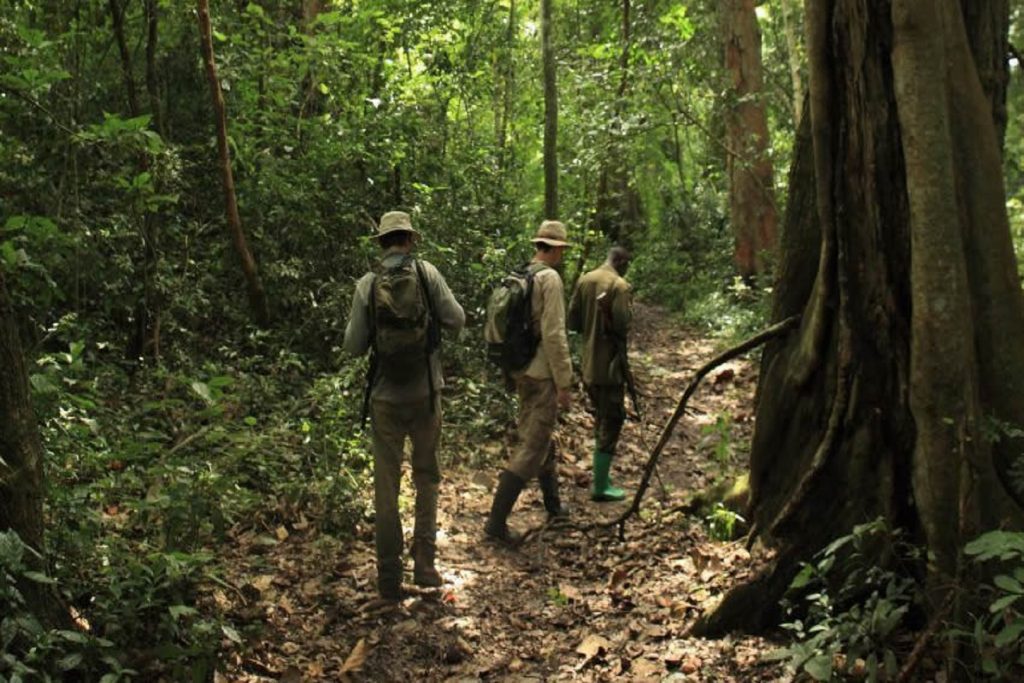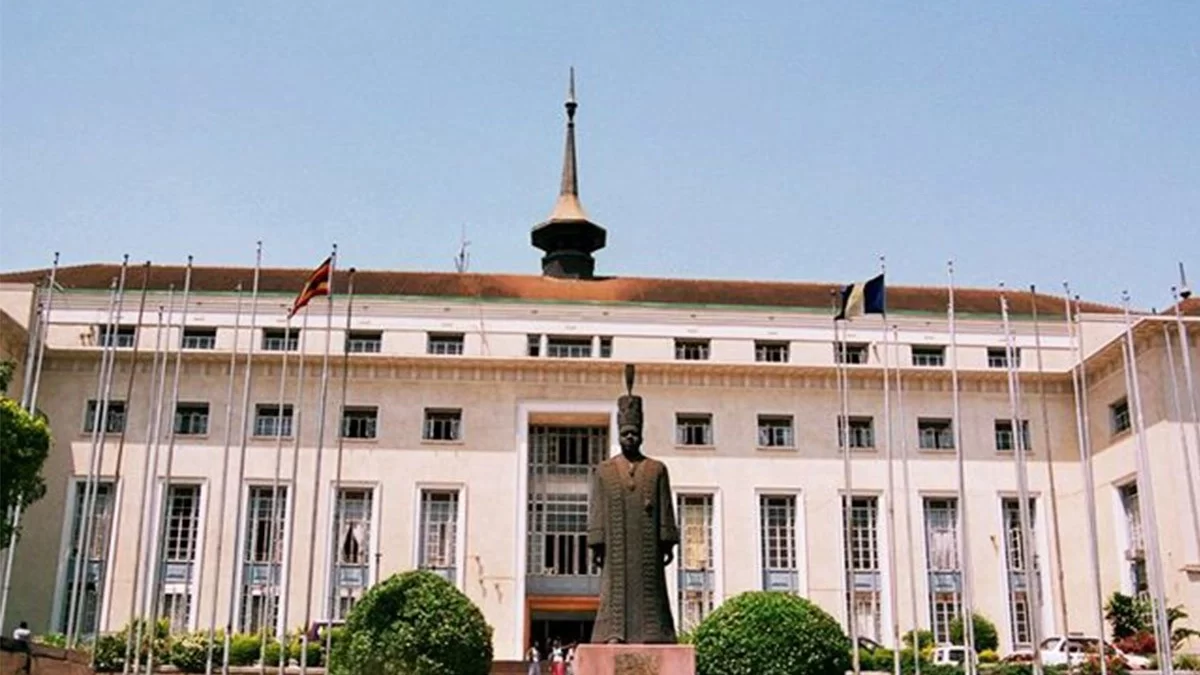
Nature Walks and Hiking in Semuliki National park
September 4, 2023
Where to see Leopards in Uganda?
September 4, 2023Explore the Parliament of Buganda Kingdom in Bulange Mengo – The Great Lukiiko
Visit the Parliament of Buganda Kingdom
Bulange, the administrative and parliamentary center of the Buganda Kingdom, stands as an emblem of tradition and governance. In days of old, meetings transpired beneath the sheltering canopy of trees, giving way to the construction of the iconic grass-thatched building we know today. The vision for Bulange was set into motion in 1955, when Ssekabaka Mutesa, returning from exile in Scotland, presented a drawing of his ideal structure. This architectural masterpiece was completed in 1958, offering an ideal setting to delve into the rich tapestry of Buganda’s history and culture. It’s important to note that, in accordance with Buganda’s cultural norms, ladies should refrain from wearing trousers when visiting this revered site. Feel free to reach out to Trek Africa Expeditions for an unforgettable journey to explore the Parliament of Buganda Kingdom and discover more about the vibrant culture of Buganda.
Idi Amin Torture Chambers at Lubiri Bulange
Nestled within the Lubiri Mengo palace of the King of Buganda, the Idi Amin torture chamber has a unique and intriguing history. Originally, this chamber served as an armory, safeguarding a cache of firearms. During the reign of President Idi Amin, this historical building took on new significance. While its primary purpose was to protect the stored weaponry, it also stands as a stark reminder of the tumultuous period during Amin’s rule. Discover this fascinating chapter of Uganda’s history when you explore Lubiri Bulange.
Gadhafi’s National Mosque
The Uganda National Mosque, proudly situated atop Kampala Hill in the Old Kampala area, is a testament to architectural grandeur. Completed in 2006, this awe-inspiring mosque can accommodate up to 15,000 worshippers within its hallowed halls. An additional 1,100 can find solace in the gallery, while the terrace extends its embrace to a further 3,500 individuals. Gadhafi’s National Mosque is a sacred space for spiritual reflection, offering a tranquil atmosphere for all who enter its gates. Plan your visit to this magnificent mosque to witness its grandeur and experience a profound sense of peace.
Nakasero Market
Nakasero Market, nestled at the base of Nakasero Hill in Kampala, invites visitors to partake in a sensory adventure. This bustling market offers a vibrant tapestry of experiences, from the freshest produce to textiles, shoes, and even affordable electronics. Located a mere 50 meters from Entebbe Road, Nakasero Market stands as one of Kampala city’s largest and most dynamic commercial hubs. Dive into the rich tapestry of sights, sounds, and flavors that define this iconic market.
The Kasubi Royal Tombs: A Glimpse into Tradition and History
The Kasubi Tombs, nestled within the heart of Kampala, Uganda, serve as the final resting place for four kabakas (kings) and other esteemed members of the Baganda royal family. Beyond their role as a sacred burial site, these tombs hold profound spiritual and political significance for the Ganda people. The architectural marvel of the Kasubi Tombs showcases traditional design and craftsmanship, with a remarkable grass-thatched hut originally constructed as a palace for Kabaka Mutesa I in 1882. Following his passing two years later, the hut was transformed into a revered burial site. Explore this poignant piece of history to gain insight into Uganda’s rich cultural heritage.
The Bahá’í Mother Temple of Africa: A Beacon of Unity
The Bahá’í Mother Temple of Africa, also known as the Mashriqu’l-Adhkar, stands as a beacon of unity and faith. As the sole Bahá’í temple on the African continent and one of only nine worldwide, its significance is profound. Located approximately three kilometers from Kampala, Uganda’s capital city, this temple has a compelling history. In 1951, English and Iranian Bahá’í followers arrived in Uganda, hoping to introduce the faith to local communities. Within a year, over 100 Bahá’í followers had gathered in Uganda. By 1958, construction began on the first and only Mother Temple of Africa. The Bahá’í Intercontinental Conference for Africa in Kampala marked this historic occasion. Explore this symbol of unity and faith, where diverse cultures come together in harmony.
Namugongo Martyrs Shrine: A Place of Reverence and Pilgrimage
Located approximately 15 kilometers east of Kampala city, the Namugongo Martyrs’ Shrine stands as a testament to unwavering faith and sacrifice. This revered site witnessed the martyrdom of over 20 Catholic and Anglican martyrs, who were burned alive on the orders of Kabaka Mwanga in June 1886. Every year on June 3rd, Christians from across Eastern and Central Africa, and beyond, converge at Namugongo to pay homage to these martyrs and renew their faith. The church, designed in the shape of a traditional Baganda hut (akasiisiira), stands on 22 copper pillars, each representing one of the 22 Catholic martyrs. The spot where Charles Lwanga, the leader of the Catholics, was burnt on that fateful day in 1886 is located beneath the altar. Pope Paul VI consecrated the church on August 2nd, 1969, further cementing its place as a site of reverence and pilgrimage.
Discover African Traditional Markets in Kampala, Uganda
Kampala city boasts a vibrant tapestry of colorful crafts markets, affectionately known as craft villages. These bustling markets offer an array of vibrant treasures, including prints, baskets, paintings, pottery, jewelry, and much more. While some markets have permanent locations, such as the Craft Village behind the National Theatre and the Craft Centre on Buganda Road, others operate on a weekly or monthly basis. Whether you’re seeking a unique memento or an opportunity to interact with local artists and request custom creations, these markets are a treasure trove of cultural riches waiting to be explored.
Journey into Uganda’s Cultural Heritage at the Uganda Museum
Established in 1908, the Uganda Museum stands as the oldest museum in East Africa. It serves as a custodian of Uganda’s rich cultural heritage, offering visitors a captivating glimpse into the nation’s ethnological and natural history. The museum’s exhibits provide a vivid tapestry of Uganda’s colorful past, showcasing traditional musical instruments, ethnographic collections, and much more. The Uganda Museum is a gateway to understanding the cultural diversity and history of Uganda, providing a compelling experience for all who visit.
Indulge in Authentic Ugandan Cuisine at Local Restaurants
Kampala boasts a diverse array of restaurants that offer a unique and refined dining experience centered around authentic Ugandan cuisine. These establishments use fresh, natural flavors, top-quality ingredients, and expert culinary techniques to craft delectable dishes that are both unpretentious and visually stunning. If you’re seeking a departure from the ordinary and a chance to savor authentic Ugandan flavors, dining at one of these restaurants is a must.
Explore the Vibrant Wandegeya Market
Wandegeya Market, located in the educational district of Kampala, exudes a youthful and energetic ambiance. This market hub is teeming with boutiques, salons, fresh produce vendors, and bustling offices. Wandegeya Market is particularly renowned for two culinary delights: the Rolex and TV Chicken. The Rolex, a beloved street food, consists of an omelet, raw tomatoes, grilled chicken, fries, and an assortment of vegetables like cabbages, tomatoes, carrots, and green peppers. Whether you’re in Wandegeya for the Rolex, TV Chicken, or both, this market promises a vibrant culinary adventure.
Plan Your Adventure with Trek Africa Expeditions
Trek Africa Expeditions specializes in crafting unforgettable journeys that allow you to explore the wonders of Kampala and beyond. Whether you’re interested in cultural immersion, historical exploration, or culinary delights, their expertise ensures a memorable experience tailored to your interests. Contact Trek Africa Expeditions to embark on your adventure and discover the captivating treasures of Kampala and Uganda as a whole.

